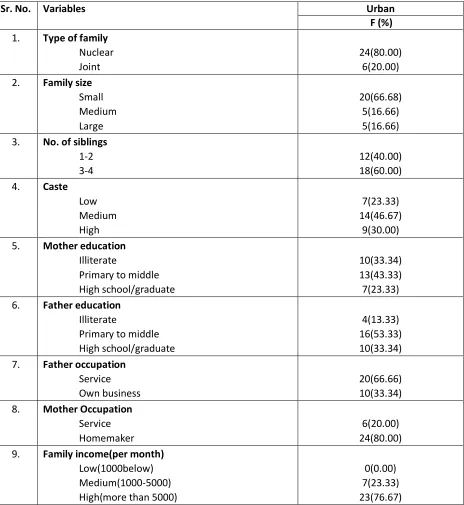A STUDY TO ASSESS IMPACT OF INTERVENTION PROGRAMME ON DEVELOPMENTAL MILESTONES OF 6-10 YEARS OF AGE CHILDREN
Nigam Rani*, Shankutla Punia **, Seema Rani* *Ph.D. Scholar, ** Professor
Department of Human Development and Family Studies, CCS Haryana Agricultural University, Hisar-125004, Haryana
Abstract
A developmental milestone is an ability that is achieved by most children by a certain age. Developmental milestones can involve physical, social, emotional, cognitive and communication skills such as walking, sharing with others, expressing emotions, recognizing familiar sounds and talking. All children develop in their own unique pace, as a direct result of both hereditary and environmental influences; there is a certain pattern of development that applies to nearly all children. Present study was undertaken in primary-schools of Hisar city of Haryana state to assess impact of intervention programme on developmental milestones of 6-10 years of group. Results of the study shows that after intervention programme significant differences were found in different developmental milestone i.e. language and physical. Thus it can be said that intervention having significant impact on developmental milestones.
Key Words; Developmental milestones, Intervention, Impact assessment of Intervention
Introduction
Objectives:
1.
Personal and socio-economic profile of children with delayed developmental milestone.2.
Developmental Gain of children with delayed developmental milestone (Physical and language).Material Methods
Present Study was conducted in Hisar city of Haryana state. Primary schools were selected from Hisar city. From primary classes 30 children were selected. These 30 children were assessed for developmental milestone (Language & Physical). A list of children was prepared on the basis of developmental level of children in descending order. From these children, 50 per cent children (15 children) with lowest developmental milestone were selected for intervention. These children were considered as children with delayed developmental milestone. Independent variables considered were personal socio-economic profile of the children. Developmental Milestones (language and physical) among children of 6-10 years age group was taken as dependent variable. In the process of assessment of developmental milestone a questionnaire was developed and used to gather the data for physical and language development of the respondents. Descriptive statistics, frequency, percentage, and mean, standard deviation was used and inferential statistics; t-test was used to analyze the data for drawing the inferences.
Intervention programme:
Intervention programme for children was developed to promote physical and language development of children with delayed milestones. Intervention programme to children was implemented for One week. Post-testing of children’s development was done after a gap of one week.
Result Discussion
Profile of the respondents
between more than Rs. 5000 per month followed by 23.33 per cent families whose income ranged between Rs. 1000-5000 only per month.
Table 1: Socio-economic profile of the respondents
Sr. No. Variables Urban
F (%)
1. Type of family
Nuclear Joint
24(80.00) 6(20.00) 2. Family size
Small Medium Large 20(66.68) 5(16.66) 5(16.66) 3. No. of siblings
1-2 3-4
12(40.00) 18(60.00) 4. Caste
Low Medium High 7(23.33) 14(46.67) 9(30.00) 5. Mother education
Illiterate
Primary to middle High school/graduate
10(33.34) 13(43.33) 7(23.33) 6. Father education
Illiterate
Primary to middle High school/graduate
4(13.33) 16(53.33) 10(33.34) 7. Father occupation
Service Own business
20(66.66) 10(33.34) 8. Mother Occupation
Service Homemaker
6(20.00) 24(80.00) 9. Family income(per month)
Low(1000below) Medium(1000-5000) High(more than 5000)
Developmental Gain of children with delayed developmental milestone
To see the difference between pre and post developmental level of the different developmental milestones (Language and Physical), t-test of significance was applied. Results shows that after intervention significant differences were found in different developmental milestone i.e. language and physical. Thus it can be said that intervention having significant impact on developmental milestones. Other studies also show impact of intervention programme. Saini&Manocha (2008) studied that majority of children had poor status of language development only 5 respondents had higher language development than their chronological age on expressive language. Not even one fourth of the respondents were able to achieve their linguistic milestone for age 3-5 years. Respondents showed poor performance on language development. In other study it was found that early identification of developmental delays should lead to early intervention that is a strategy to maximize development so as to minimize delays. Estimates in the literature indicate early intervention yields an effect size of nearly one-half to three-quarters of a standard deviation (Shanwal, P. 2006). The earlier a delay is identified, and thus intervention begins, the greater the likelihood a disability is prevented, or minimized, and the lesser the impact on the overall functionality of the child and family (Williams, Mughal, & Blair, 2008).
Table 2: Mean differences in developmental gain of different developmental milestones
Developmental
Milestones
Pre test
Mean ± S.D.
Post test
Mean ± S.D.
t-values
Language Development 22.20±2.56 24.86±2.31 4.22**
Physical Development 22.63±2.31 24.26±2.33 2.72**
Bibliography:
Beach,J. and Friendly,M. 2007.Quality by design: Elements of a high quality early learning and child care system.Toronto: Childcare Resource andResearch Unit, University of Toronto.Retrieved from www.learningbenefits.net.
Kumari, L.,Chhikara, S. 1998. Development and assessment of social cognition tool for 8-10 years children. Unpublished Ph.D Thesis, CCS HAU, Hisar.
Nores, L. and Barnett, P. 2010. Attraction and close relationships. Handbook of social psychology, 1:96-112.
Shanwal, P. 2006. Intervention Programme for delayed motor development of 2-3 years old rural children. Unpublished M.Sc Thesis, CCS HAU, Hisar.
Saini, R. 2008. Language and environmental stimulation of 3-5 years old rural children.Unpublished M.Sc Thesis, CCS HAU, Hisar.
